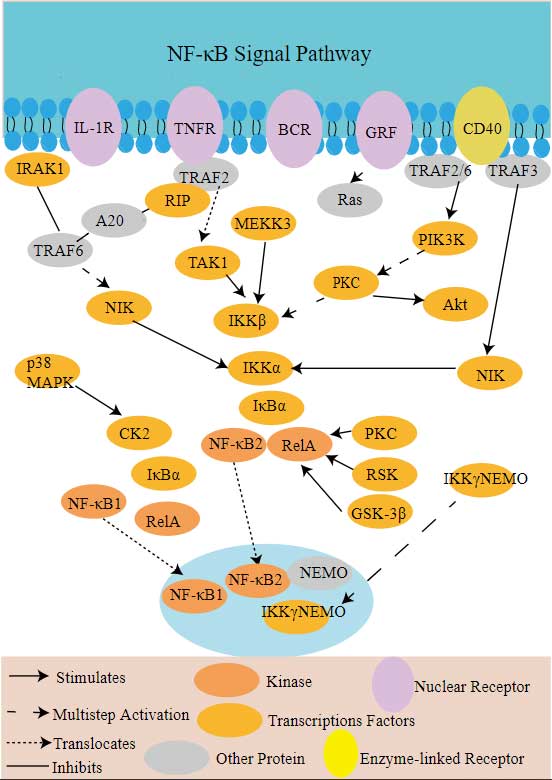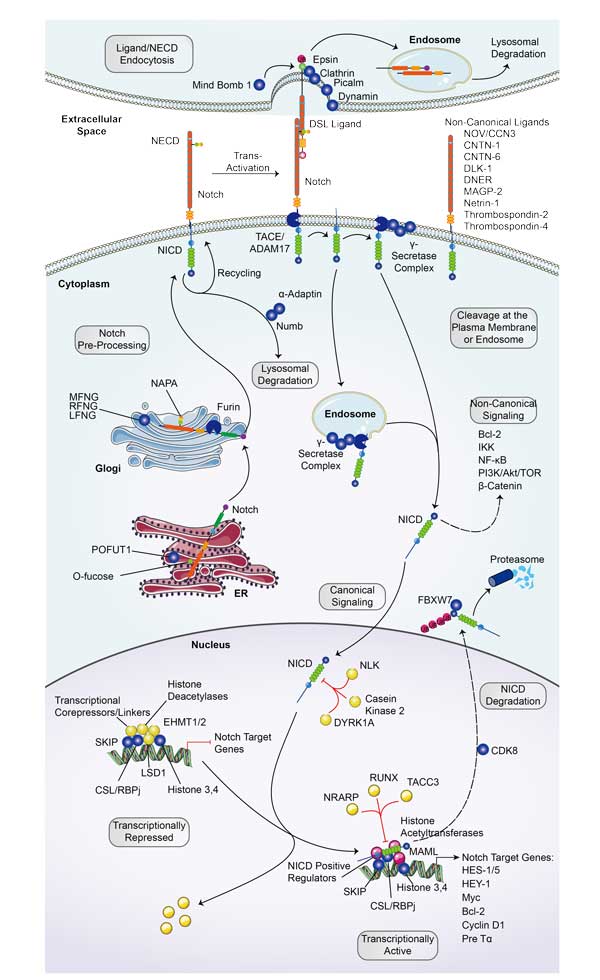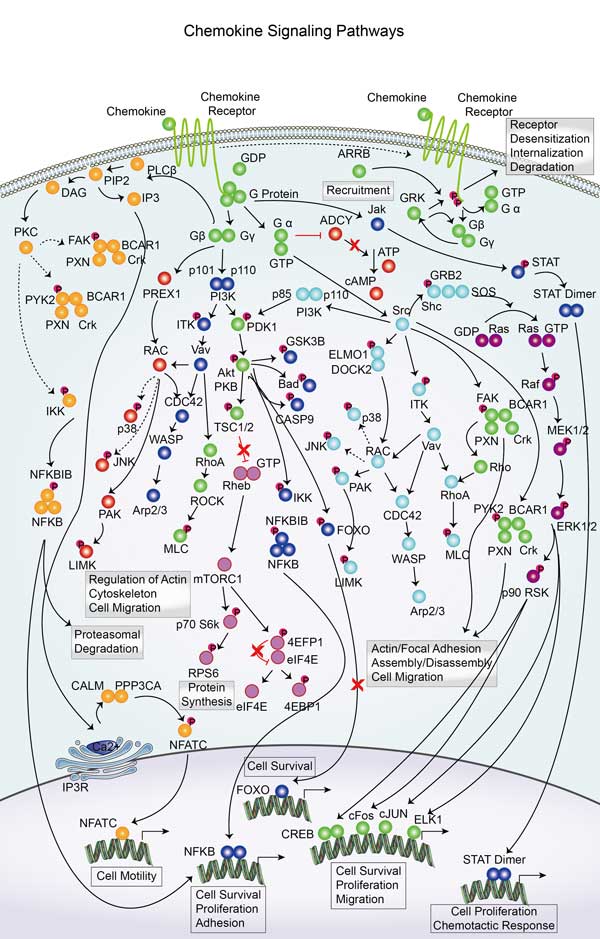NFKB1
-
Official Full Name
nuclear factor of kappa light polypeptide gene enhancer in B-cells 1 -
Overview
This gene encodes a 105 kD protein which can undergo cotranslational processing by the 26S proteasome to produce a 50 kD protein. The 105 kD protein is a Rel protein-specific transcription inhibitor and the 50 kD protein is a DNA binding subunit of the NF-kappa-B (NFKB) protein complex. NFKB is a transcription regulator that is activated by various intra- and extra-cellular stimuli such as cytokines, oxidant-free radicals, ultraviolet irradiation, and bacterial or viral products. Activated NFKB translocates into the nucleus and stimulates the expression of genes involved in a wide variety of biological functions. Inappropriate activation of NFKB has been associated with a number of inflammatory diseases while persistent inhibition of NFKB leads to inappropriate immune cell development or delayed cell growth. Two transcript variants encoding different isoforms have been found for this gene. -
Synonyms
NFKB1;p50;KBF1;p105;EBP-1;MGC54151;NFKB-p50;NFkappaB;NF-kappaB;NFKB-p105;DKFZp686C01211;nuclearfactor NF-kappa-Bp105subunit;NF-kappabeta;OTTHUMP00000161765;OTTHUMP00000216418;OTTHUMP00000219572;DNA binding factor KBF1;nuclear factor NF-kappa-B p50 subunit;nuclear factor kappa-B DNA binding subunit
Recombinant Proteins
- Human
- Mouse
- Chicken
- Rat
- Rhesus macaque
- Cattle
- E.coli
- Mammalian Cells
- HEK293
- Wheat Germ
- Sf21 Cells
- HeLa
- In Vitro Cell Free System
- GST
- His
- Non
- T7
- DDK
- Myc
- MBP
- Avi
- Fc
- Flag
Involved Pathway
NFKB1 involved in several pathways and played different roles in them. We selected most pathways NFKB1 participated on our site, such as MAPK signaling pathway,Ras signaling pathway,cAMP signaling pathway, which may be useful for your reference. Also, other proteins which involved in the same pathway with NFKB1 were listed below. Creative BioMart supplied nearly all the proteins listed, you can search them on our site.
| Pathway Name | Pathway Related Protein |
|---|---|
| TNF signaling pathway | CREB5,IL1B,CREB3L1,SELE,RELA,MAP3K5,CXCL2,Ccl12,TRAF3,IL15 |
| MicroRNAs in cancer | MAPK1,TPM1,CCNG1,TP63,PRKCA,CCND1,HMGA2,SPRY2,RASSF1,TNXB |
| Amoebiasis | TLR4,PIK3R2,SERPINB9,CXCL1,PIK3CB,IL1B,C8G,LAMB4,SERPINB13,ADCY1 |
| Prolactin signaling pathway | MAPK3,PPIB,SOCS5,MAP2K1,MAPK8,STAT5A,MAPK1,GALT,ESR1,RELA |
| NOD-like receptor signaling pathway | IL1B,PSTPIP1B,CASP8,NFKBIA,MAPK12B,MAPK8,CCL5,HSP90AA1,IL6,TNFAIP3 |
| Salmonella infection | TLR4,ACTB,FLNC,DYNC1LI1,CXCL1,IL6,TLR5,RILP,ARPC5LB,CDC42 |
| Toll-like receptor signaling pathway | MAP2K3,TNF,CCL4,AKT2L,CXCL10,TLR4BA,TRAF6,IFNA7,MAPK12A,MAP2K6 |
| HIF- signaling pathway | GAPDH,RPS6KB2,PIK3CB,VEGFA,NOS3,NPPA,AKT2,NOX1,MKNK2,INS |
| Legionellosis | NAIP7,HSF1,BCL2L13,ITGB2,Itgam&Itgb2,C3,EEF1G,HSPD1,TLR4,EEF1A2 |
Protein Function
NFKB1 has several biochemical functions, for example, RNA polymerase II distal enhancer sequence-specific DNA binding,RNA polymerase II regulatory region sequence-specific DNA binding,actinin binding. Some of the functions are cooperated with other proteins, some of the functions could acted by NFKB1 itself. We selected most functions NFKB1 had, and list some proteins which have the same functions with NFKB1. You can find most of the proteins on our site.
| Function | Related Protein |
|---|---|
| actinin binding | MICALL2,PKD2,RELA,PDLIM5,CSRP3,TTN,PROM1 |
| chromatin binding | RCC1,HMGB3,CUX1,WACA,MSL1,POU4F2,PDX1,HESX1,SVEP1,SOX15 |
| transcriptional repressor activity, RNA polymerase II transcription regulatory region sequence-specific binding | ISX,FOXD3,AEBP1,ETV7,FERD3L,PCGF6,CDX2,VAX2,JARID2,HIST2H3A |
| RNA polymerase II distal enhancer sequence-specific DNA binding | MED12,NR5A2,BACH1A,NR2F6,ARID3B,SFPI1,MEOX2,SFPQ,ATF2,GZF1 |
| transcription factor activity, sequence-specific DNA binding | HIVEP2,ZHX1,Trl,NFE2L2A,ZFP35,ZNF167,ZNF483,ZNF311,PTTG1,CBL |
| transcriptional activator activity, RNA polymerase II distal enhancer sequence-specific binding | NFE2L2,PBX3,FOXH1,ZEB2,POU4F1,SIX6,MEOX2,REL,NFE2L1,TARDBP |
| RNA polymerase II regulatory region sequence-specific DNA binding | ATF3,GATA2A,CREB3,ZNF711,LEF1,PKNOX2,SOHLH1,TAL1,ATF4,HOXD9 |
| protein binding | ITGB5,PAK3,KRTAP3-1,HMG20A,STK39,SETD2,FOXH1,CKM,FBXL3,HILPDA |
| regulatory region DNA binding | IRF1A,IRF6,HMGA2,IRF5,IRF8,IRF2A,IRF3,IRF4A,IRF1B |
Interacting Protein
NFKB1 has direct interactions with proteins and molecules. Those interactions were detected by several methods such as yeast two hybrid, co-IP, pull-down and so on. We selected proteins and molecules interacted with NFKB1 here. Most of them are supplied by our site. Hope this information will be useful for your research of NFKB1.
MAP3K8;RELA
NFKB1 Related Signal Pathway
Resources
Research Area
Related Services
Related Products
References
- Chen, Y; Lu, RQ; et al. The NFKB1 polymorphism (rs4648068) is associated with the cell proliferation and motility in gastric cancer. BMC GASTROENTEROLOGY 15:-(2015).
- Jacque, E; Schweighoffer, E; et al. IKK-induced NF-kappa B1 p105 proteolysis is critical for B cell antibody responses to T cell-dependent antigen. JOURNAL OF EXPERIMENTAL MEDICINE 211:2085-2101(2014).







